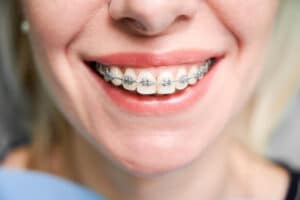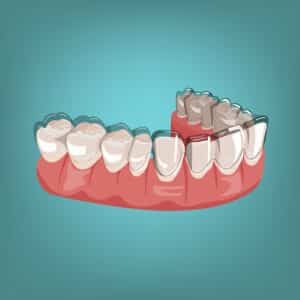So, you’ve decided it’s time to straighten your teeth, but you’re stuck in the classic dilemma: aligners vs. braces—which is better? Don’t worry; you’re not alone! It’s a big decision that can affect your smile and overall dental health, and it’s essential to choose what’s right for you.
Understanding Braces
Types of Braces

- Traditional Metal Braces: The classic option. They’re made of metal brackets and wires and are affixed to the front of your teeth.
- Ceramic Braces: These are a bit more discreet. They use clear or tooth-colored brackets, so they’re less noticeable.
- Lingual Braces: The stealthy choice! Lingual braces are placed behind your teeth, so they’re almost invisible to the outside world.
How Braces Work
Braces use a combination of brackets, wires, and bands to move your teeth. The brackets are attached to your teeth, and the wires are threaded through them. These wires apply gentle pressure to your teeth, encouraging them to shift into the correct position over time. Think of it as a little nudge in the right direction.
Understanding Aligners
Aligners offer a modern, less conspicuous alternative to traditional braces. Here’s how they operate:
- Customization: Aligner treatment begins with a detailed 3D scan of your mouth. This scan serves as the blueprint for crafting your personalized aligners.
- Custom Aligners: Based on the scan, a set of custom aligners is created specifically for your unique dental needs. Each aligner in the series is designed to make incremental adjustments to your teeth’s positions.
- Gradual Progress: Rather than a one-time installation like braces, aligner treatment involves a series of aligners, each slightly different from the previous one. These aligners work together, gradually moving your teeth into their desired alignment.
The Gradual Movement Process
In comparing aligners vs. braces, know that aligners take a subtle yet effective approach to straightening teeth. With each new aligner in the series, your teeth shift incrementally. It’s like a gentle, ongoing journey to your ideal smile.
Typically, you wear each set of aligners for about one to two weeks before moving on to the next set. Consistency is crucial here; following your orthodontist’s instructions is key to achieving the best results. Plus, since aligners are custom-made to fit your teeth precisely, they are designed with your comfort in mind.
Unlike braces, aligners generally result in fewer issues with mouth and gum discomfort. There’s usually no need for cuts on the inside of your cheeks, and you won’t have to deal with salt rinses.
Aligners vs. Braces: PROS and CONS of Aligners
 PROS
PROS
When looking at aligners vs. braces, aligners offer several benefits that make them an attractive option for those seeking orthodontic treatment. These advantages include:
1. Nearly Invisible Appearance
One of the most significant advantages of aligners is their discreet nature. Unlike traditional braces, which can be quite noticeable, aligners are clear and virtually invisible. Adults who may not want to draw attention to their orthodontic treatment particularly value this feature. Teenagers and self-conscious individuals also find comfort in the fact that their aligners are not immediately visible to others.
2. Convenient Eating Habits
A common question people have is, “Do you have to wear aligners all the time?” The answer is that you should wear them for about 20 to 22 hours each day for the best results. However, aligners have a distinct advantage when it comes to eating. You can easily remove them before meals, which means you don’t have to alter your diet or worry about certain foods getting stuck in your braces. This flexibility makes aligners a practical choice for those who love their snacks and varied diets.
3. Maintaining Oral Hygiene
With aligners, keeping your teeth clean is a breeze. You remove your aligners for brushing and flossing, just like you did before orthodontic treatment. Since there are no brackets or wires to navigate around, your oral hygiene routine remains familiar and effective. This helps reduce the risk of cavities, plaque buildup, and bad breath commonly associated with braces.
4. Fewer Orthodontic Visits
Aligner treatment often requires fewer in-person visits to your orthodontist compared to traditional braces. Much of the customization and planning occurs before you even start wearing your aligners. Once your series is ready, you simply follow your orthodontist’s guidance on when to switch to the next set. This convenience translates to fewer disruptions to your daily routine and less time off work or school.
5. Comfortable to Wear
While aligners may cause some discomfort or pressure as they gradually move your teeth, they typically result in fewer mouth and gum problems compared to traditional braces. Aligners are crafted from a specialized plastic that fits snugly and comfortably over your teeth, reducing the likelihood of cuts on the inside of your cheeks or the need for salt rinses.
CONS
While aligners offer various advantages, it’s essential to weigh them against the potential disadvantages to make an informed choice regarding your orthodontic treatment.
1. Need for Patient Discipline
One of the significant advantages of aligners is also a potential disadvantage. The ability to remove aligners is a pro because it allows for easy eating and oral hygiene. However, it can become a con if you’re not disciplined about putting your aligners back in promptly after meals or brushing. To achieve the best results, aligners should be worn for about 20 to 22 hours daily. If you fall short of this, your treatment may not progress as intended. Patient compliance is a crucial factor in alignment success.
2. Inconvenience of Removing Aligners
Aligners need to be removed before eating or drinking anything other than water. While this offers the freedom to enjoy a wide range of foods, it can be inconvenient in social settings. You’ll need to discreetly remove your aligners, store them safely, and then brush your teeth before putting them back in. Neglecting these steps can lead to food particles interfering with tooth movement, staining of the aligners, and an increased risk of cavities and bad breath.
3. Cost Considerations
You might be wondering, “aligners vs. braces, which is cheaper?” The cost of aligners can be similar to braces, thanks to advancements in 3D scanning technology and the flexible materials used for aligner fabrication. However, it’s essential to note that some orthodontic issues may be challenging or even impossible to address with aligners alone. Your orthodontist may recommend a combination of aligners and braces to achieve the desired results, potentially increasing the overall cost. Additionally, specialized options like lingual (inside) braces or fully custom aligners can also be more expensive than traditional braces.
4. Limitations for Complex Cases
Aligners are not suitable for all orthodontic cases. They are generally recommended for straightforward to moderately complex issues. Before deciding on aligners, consult your orthodontist to determine if they can achieve the same results as traditional braces or other methods for your specific case. An experienced and ethical orthodontist will provide you with honest guidance on the most suitable treatment options for your unique situation.
Aligners vs. Braces: PROS and CONS of Braces
 PROS
PROS
In comparing aligners vs. braces, braces are more noticeable but they offer several advantages that make them a reliable choice for many orthodontic patients. Let’s explore the pros of braces:
1. Suitable for All Treatments
Braces are incredibly versatile and can address a wide range of orthodontic issues, no matter how complex they are. Whether you have multiple dental and facial concerns that need correction, braces can be used to tackle each one effectively. They rely on anchors and an archwire to exert precise and powerful forces, making them suitable for even the most challenging cases. So, if you have a more intricate orthodontic puzzle to solve, braces can be a go-to solution.
2. Potential for a Perfect Result
Braces apply a significant amount of force, which makes it possible to produce an exceptionally precise result. If you’re looking for the absolute best outcome and don’t mind the somewhat longer treatment duration, braces might be the right choice. They have the power to move teeth into the desired position with a high degree of accuracy, making them a top contender for those seeking perfection in their smiles.
3. Variety of Braces Types
Traditional metal braces are just one option among several. Patients now have the choice of different types of braces to suit their preferences:
- Lingual Braces: These braces are placed on the inner surface of your teeth, making them virtually invisible from the outside.
- Ceramic Braces: Ceramic brackets and wires are tooth-colored, making them less conspicuous compared to traditional metal braces.
So, if you’re concerned about the aesthetics of braces, there are alternative options that offer the power of braces without the prominent metal look.
4. Faster Treatment Time in Some Cases
If you’re eager to complete your orthodontic journey as quickly as possible, braces often provide faster treatment times for specific issues. When it comes to closing gaps and aligning teeth, braces can be the faster option. However, the skill and experience of your orthodontist also play a role in the pace of your treatment, so choose your specialist wisely.
CONS
While braces offer significant benefits, it’s essential to consider their potential downsides when making your decision. Let’s take a closer look at the disadvantages of traditional braces:
1. Aesthetics of Braces
One of the most commonly cited drawbacks of traditional braces is their appearance. Some people feel self-conscious about the noticeable metal brackets and wires, particularly in social or professional settings. If the aesthetics of your orthodontic treatment are a major concern, this is something to keep in mind.
2. Brushing Your Teeth
Maintaining oral hygiene with braces can be a bit more challenging than with aligners. Brackets and wires create nooks and crannies where food particles and plaque can accumulate. Proper brushing and flossing techniques are essential to prevent staining, decay, and gum issues. Your orthodontist will guide how to maintain good oral hygiene while wearing braces.
3. Diet and Food Preparation
Braces come with dietary restrictions. Hard, sticky, or chewy foods can potentially damage the archwire or dislodge a bracket. When these incidents occur, it can prolong your treatment time until the issues are repaired. Patients with braces must be mindful of their food choices and take precautions to avoid certain items.
4. Regular Consultations
Braces require more frequent visits to the orthodontist for adjustments and progress checks. Typically, you’ll need to visit your orthodontist once a month to monitor how your teeth are moving and make necessary adjustments. While these visits are essential for the success of your treatment, they do require a more significant time commitment compared to aligners.
Get Started on Your Smile Makeover
At Bracesetters Orthodontics, we’re dedicated to helping you achieve the smile of your dreams. Whether you’re a kid, a teenager, or an adult, we have the perfect orthodontic solution for you. Our orthodontist will help you look into aligners vs. braces, and make the wisest choice based on your case.
- Invisalign: Enjoy the benefits of clear aligners that are virtually invisible with this leading orthodontic aligner brand on the market. No matter your age, Invisalign can discreetly straighten your teeth.
- Braces: Choose from various options, including traditional metal braces, ceramic braces for a more discreet look, and LightForce braces for efficient and precise treatment.

 PROS
PROS PROS
PROS